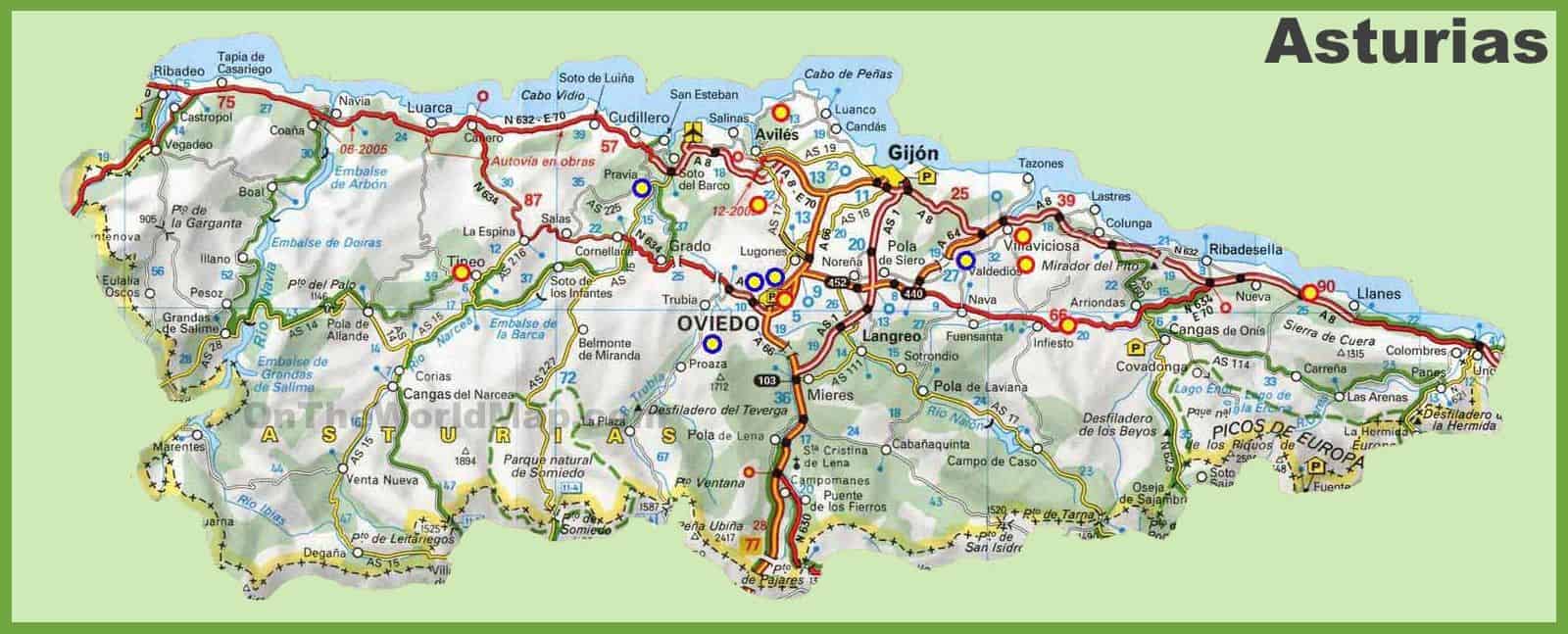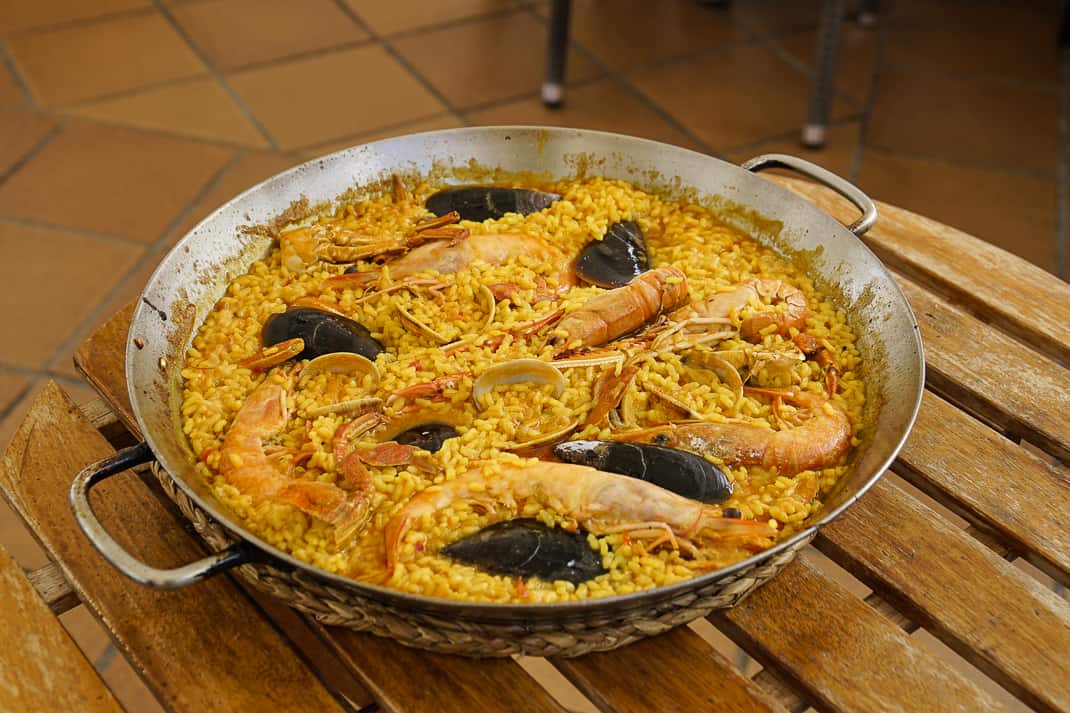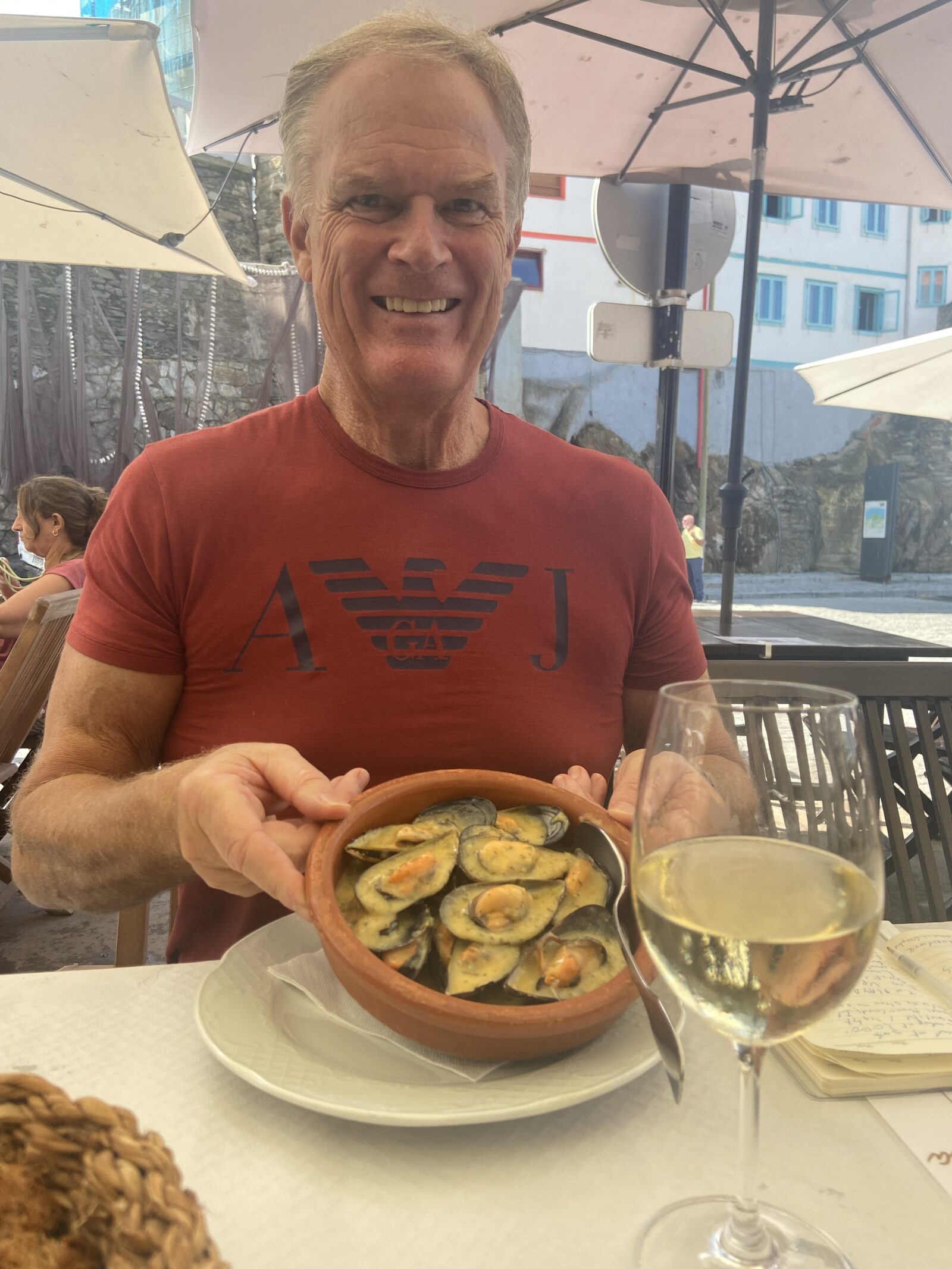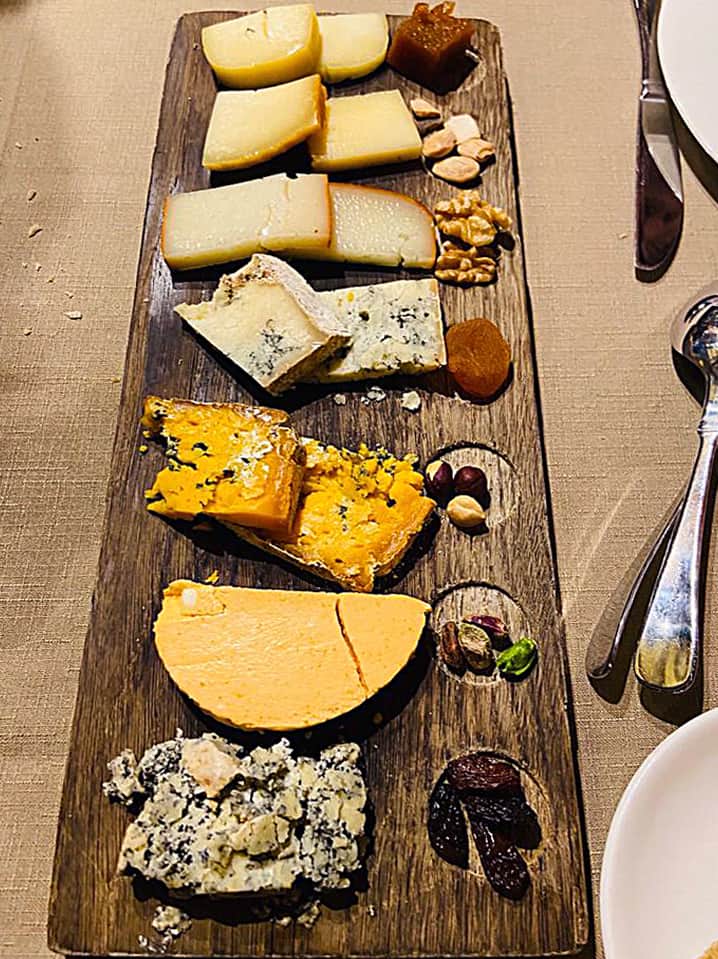Asturian cuisine: Spanish comfort food hits sweet spot with beans and sausage but cider hits a sour note

GIJON, Spain — As an American I’m well acquainted with comfort food. I think we invented it, didn’t we? How else do you explain world obesity? We invented McDonald’s and Burger King and Kentucky Fried Chicken. I consider that comfort food for many Americans — especially at 1 o’clock in the morning.
But we were also raised in the U.S. on other comfort food. Food our mothers whipped up that made your house smell of warmth and goodness. Macaroni and cheese. Pot roast. Potatoes and gravy. Meatloaf. None of it was aesthetically pleasing but it filled the stomach for hours and led to inevitable food comas.
Every country has its comfort foods. Here in Spain, I traveled to what Spaniards call the country’s comfort food capital. The region of Asturias is a little sliver of land covering 250 miles along Spain’s northwest coast. It’s cold. It’s wet. It’s covered in forest. San Lorenzo Bay is so cold, swimming season here is pretty much July 15.
In the winter, Asturias is often in the low 40s with rain at least 12 days a month. It’s the perfect place to curl up in a warm restaurant near the crashing waves and dive into thick stews of beans and bacon, clay pots of juicy marinated sausage and big chunks of stinky cheeses.


Don’t come to Asturias for the star of Spanish cuisine. Tapas aren’t big here. At least, they’re not as big as in Valencia where they’ve developed an entire culture of the little plates of local delicacies. During our recent four days in Asturias, we didn’t see any small plates of anything. Every serving, even the appetizers, were big enough to provide a doomed bull his last meal.
While we came for Asturias’ stunning coastal scenery, the food was a pleasant bonus, kind of like Bulgarian cuisine was for me in May.
Asturian cuisine is also famous for its seafood. I had a huge bowl of mussels at La Paloma in the charming, colorful port town of Cudillero, and a massive seafood paella at Mirador de la Toro, a scenic, high-end restaurant overlooking a beach in Lastres.


Fabada
But I came to Asturias intent on trying its most famous dish. Fabada is a thick, hearty stew made of beans, chorizo (sweet ground sausage seasoned with paprika), morcilla (blood sausage) and pig’s cheek in a chicken stock liberally spiced with paprika, garlic, olive oil and saffron.
The fabas de la granja are thick, fat white beans that have been cultivated in Asturias for centuries. The Asturians marinate them in Serrano ham broth for six to eight hours, making them so soft they melt in your mouth. When thrown in with the chorizo, morcilla and pig’s cheek they develop a strong, smoky flavor, perfect with crusty homemade brown bread.

On our first night out in Gijon, Asturias’ biggest city, we went to the place in town for traditional Asturian cuisine. Ciudadela is an elegant restaurant with brown, hand-woven tablecloths, matching napkins and Spanish wine bottles lining the walls. Latin love songs fill the air.
Arriving at 8:15 p.m., we were way early for Spain where if you eat before 9 you’ll likely dine alone. We ordered a starter of polpo (octopus) and potato salad that came out warm and fresh and was the best polpo I’ve ever had and, in Rome, polpo is on every seafood menu.
My fabada main course was scrumptious. The big, soft, white beans blended perfectly with the fat, juicy chunks of smoked sausage. The blood sausage soaked up all the fragrant juices, perfect for dipping bread. Like Asturias’ coastline, fabada definitely lived up to its billing.

Asturian cheese
On our second night we took a friend’s learned recommendation. Andy Hood, my old cycling writer colleague, has lived in Leon, about 90 miles south of Gijon, for 20 years. He and his wife MJ often cycle along Northern Spain’s coast then stop at La Galana for a hearty meal.
It’s right on beautiful Plaja Mayor and its elegant Town Hall, lit to a golden glow. We took an outdoor table and did the Asturian version of tapas. First came out the long Asturian Cheese Plate with seven local cheeses arranged from strongest to lightest. They’re nearly all named for the villages where they’re produced and give Asturias’ other nationally known handle — The Land of Cheeses:
Ahumadu de Pria – A smoked cheese with a milky texture aged two to six months. It’s one of Spain’s oldest cheeses.
Afuega’l pitu colorau — Soft and fatty.
Gamoneu — Lightly smoked.
La Peral — A delicate bleu cheese.
Vidiago — A soft white cheese from Asturias’ eastern border with Cantabria.
Casein — A hard cheese with a strong dairy flavor.
Cabrales — My favorite. It’s a crumbly, strongly pungent bleu cheese aged six months in mountain caves on Asturias’ eastern outskirts. The cool, dark environment from the dripping stalactites is perfect for producing the penicillin mold (didn’t know that was mold, did you?) that develops in the cheese.

Chorizo a la sidra
On Day 3, we returned to Plaza Mayor and despite Covid’s effect on tourism and September chill making beachcombing less appealing, we struggled finding a table anywhere in the scenic area. The only place with room had a red warning flag the size of the Chinese flag above Tiananmen Square.
An outdoor menu in three languages.
But La Farola wasn’t a tourist trap. It’s a subdued place with outdoor tables wrapped around a dark corner. I ordered the other Asturian diet staple. Chorizo a la sidra is thick chunks of lean local sausage fried in olive oil and apple cider. Seventeen of them came in a traditional small clay pot. Covered in a hearty red sauce, it was a pork-lover’s delight and a vegetarian’s nightmare.

Croquetas de jamon
You can get croquetas de jamon all over Spain, but the ham croquettes are special in Asturias. As renowned Spanish chef Jose Andres told Anthony Bourdain, “Everybody says Asturias has the best croquetas in Spain and in the world — especially the people of Asturias.”
Across the street from our hotel stood Il Bovino. It’s a big, airy, casual place where people sit outside and drink and eat and socialize. Local business people fill the place for lunch. It’s where we wanted a quick snack. Croquetas de jamon seemed small and harmless.
Instead, 12 fat, fried squares came on a wooden tray. Unlike most croquettes around the world, these have no cheese. Instead it’s a bechamel sauce with leftover bits of Serrano ham, Spain’s most famous ham.
In Spain it’s considered a poor man’s food. It’s easy to make and very filling and absolutely blasts with flavor. I didn’t know if I was eating ham-flavored mashed potatoes or a delicate melted cheese-ham blend.

Sidra
I saved the worst for last.
All of Asturias’ above traditional dishes are best served with Asturias’ traditional drink. Sidra is Asturias’ alcoholic cider that has been around since, apparently the 1st century B.C. That’s when Strabo, a Greek geographer, noted that “the Asturians have a drink they call Zythos made from fermented apple juice.”
Today, Asturias produces 80 percent of Spain’s cider and in 2002 a Denominacion de Origen Protegida (DOP) Sidra de Asturias was given to 21 Asturian ciders that meet high technical and quality standards. They can only use Asturian apples.
Nearly every town in Asturias has a sidreria and the heart of the sidra-drinking culture is Calle de la Gascona in the Asturian capital of Oviedo that’s lined with packed sidrerias like bars on Bourbon Street. Gascona is called el bulevar de la sidra (the cider street).
Half the tradition of sidra drinking is how you pour it. It comes in big liter-sized bottles and ice cold. The method is to hold the bottle as high as possible and let the sidra cascade into a tall wide glass below on a table or in your other hand. That gives it its fizz taste. Then you quickly shoot it like a shot of tequila before the fizz fades. It’s fun. It’s different. It’s traditional. Only one problem.
Sidra sucks.
Always willing to try something once (especially when it’s alcohol), I was especially eager to abide. I saw myself sidreria hopping for four days, bringing a bottle home and entertaining friends with my uncanny pouring accuracy.
At Il Bovino, the waiter didn’t trust me. While giving me the bottle, he gave me a plastic contraption you place over the top of the bottle and the glass in a cup container below it. Push a button and a perfect amount of fizzy sidra is spit into the glass.
With no English, he pantomimed the shooting motion with the glass. I did as told and my eyes immediately closed. One eye tried to pry open. It was so sour my lips stuck out far enough to kiss the far wall. The waiter laughed.
I thought it may be an acquired taste in Spain, kind of like bullfighting. It was similar to bullfighting in its disgusting appeal. I somehow managed to straight shoot three-quarters of a bottle with absolutely no help from Marina. She showed a pitiful lack of courage and took one dainty sip. Then her eyes turned inside out.
I didn’t take another sip despite being surrounded all week by tables of Spaniards throwing sidra around the room.
Instead, pass the fabada.
In case you want to go …
How to get there: Iberia has numerous daily flights of 70 minutes from Madrid to Gijon starting at 92 euros in fall.
When to go: July and August are ideal for swimming. The water isn’t quite as cold but beaches are painfully crowded with Spanish tourists. Traffic is horrific. However, it is the driest. Rain only seven days a month in summer, from 10-12 days all other months. Temperatures range from 55-75 from June to September, 41-56 in winter.
Where to stay: Silken Ciudad Gijon, Bohemia 1, 34-985-176-112, www.hotelciudadgijon.com, hotel.ciudadgijon@hoteles-silken.com. Big, spacious rooms with a lobby bar. Spa with indoor pool and Jacuzzi. Big breakfast buffet included. It’s about a 15-minute walk from sea. We paid 88 euros a night for four nights.
Where to eat: Restaurante Ciudadela, Calle de Capua 7, Gijon, 34-985-34-7732, www.restauranteciudadela.com, 12:30-4 p.m., 8 p.m.-midnight Tuesday-Saturday, 12:30-4 p.m. Sunday. Excellent, stylish place near sea for traditional Asturian cuisine such as the trademark fabada, a stew of sausage and soft white beans.
La Farola, Calle San Bernardo No. 2, Gijón, 34-985-172-543, www.restaurantesidrerialafarola.com, noon-4 p.m., 7-midnight, closed Wednesday. Casual, inexpensive place that doubles as a sidreria.
Il Bovino, Carretera Vizcaina 64-66, Gijon, 34-984-053-639, www.bovino.es, info@bovino.es, 9 a.m.-midnight, Sunday noon-6 p.m., Monday closed. Modern, casual restaurant popular with working lunch crowd. Long list of appetizers and local favorites.
Mirador de Toro, Av. Ctra. de Toro 42, Llanes, 34-985-40-882, www.miradordetoro.com, 1-4 p.m., 8:15-11 p.m. Elegant, romantic high-end restaurant with beautiful view of beach and sea. Excellent fresh seafood from 16-34 euros.
For more information: Gijon Turismo, Espigon Central de Fomento, 34-985-34-1771, www.gijon.info. 10 a.m.8- p.m. May-October, 10 a.m.-2:30 p.m. and 4:30-7:30 p.m. November-April. There is an information booth in summer at Playa de San Lorenzo.


September 29, 2021 @ 1:47 pm
Oh, John! Be nice. Sidra is not so bad.
In a past life I used to take college kids to Spain for Summer study abroad. We stayed for weeks at a time in different regions of Spain. Galicia was one of my favorite regions, and sidra is also their alcoholic drink of choice. I learned to love it so much that I now drink hard cider anytime I see it on the menu in the States. Italians hate it though. One year I decided to share my love of Sidra with my Italian family by bringing them a bottle. That did NOT go over well! LOL!